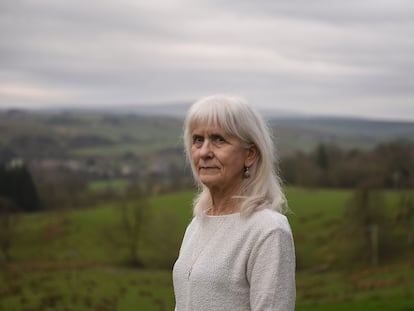Arturo Goicoechea, neurologist: ‘What we usually explain to patients about chronic pain is incorrect’
The doctor talks to EL PAÍS about how the brain perceives physical suffering, and why there needs to be a paradigm shift in what we teach children about fear
Neurologist Arturo Goicoechea, 77, is convinced that the traditional way of understanding pain is wrong, and that millions of people are being failed by the medical system.
Goicoechea, who was head of the Neurology Service at the Santiago de Vitoria Hospital in Spain for more than three decades, has just published a book called El dolor crónico no es para siempre (in English, Chronic Pain Is Not Forever), which seeks to give hope to the millions of people who suffer from the condition.
“What we usually explain to patients about chronic pain is incorrect,” he says. The neurologist also suffered years of unexplained pain due to his brain’s overly sensitive alarm system that went off for no real reason. He was able to deactivate the system by explaining to himself where those erroneous signals were coming from.
Question. What would be the correct explanation for chronic pain?
Answer. In the body, we have sensors to take data from inside our body, and we assume that what reaches our consciousness directly reflects that internal universe. That is not true. What reaches our consciousness, in this case a perception of something internal, is a construction of the brain, the result of a historical interpretation of the consequences of the organism’s interaction with the environment. We live in a kind of virtual reality thanks to which we can interact adaptively with the outside world. Based on this premise, feelings such as pain do not come out of the tissue area where we feel it, it is something the system builds and projects to consciousness. We have to find out if there is something that justifies and properly explains the pain that we feel, or if there’s no cause, which is the basic problem that patients with chronic pain have. I’m hurting a lot, I go to the doctor, and they tell me that there’s nothing wrong with me, that they can’t find the cause, and without knowing the cause it is difficult to do an effective job of finding the solution.
Q. What do you propose as an alternative to conventional treatments?
A. We propose providing information to the system so that, from our consciousness, we can modify the beliefs and expectations that do not conform to what is happening. To inform the brain that its state of alert is not justified and that the only thing it causes is suffering or disability. To produce this change, we explain basic concepts of biology and neuroscience, how the body’s defense system is organized, how this system depends on information and culture, and how the placebo effect works. In this way, we help the patient so that, when they feel pain, they know how to interpret it correctly and do not create a positive feedback loop thinking about what the system previously projected onto the consciousness. It’s about reversing the loop, transmitting that you can move freely, that your activity will not cause harm and that your body needs the activity, because that’s what’s healthy. But for that to happen, you have to take away the fear of movement and fear is vanquished with knowledge.
Q. In the book, you also warn of the risk of unnecessary tests, which can feed this negative loop.
A. Good practice guidelines recommend that, in the absence of what are called red flags — symptoms or examination findings that suggest that there is something that should be investigated — imaging tests should not be performed, because it creates inadequate information. For example, my lower back hurts, a scan or an MRI is done, and it reveals disc protrusions, osteoarthritis… So, I say, ‘it hurts because you have these protrusions or osteoarthritis,’ even though many studies looking for a correlation between these findings and the pain have found none. These changes are adaptive, not degenerative. Many people have these changes and do not feel pain. With this diagnosis, we are promoting the idea of a fragile, vulnerable organism.
Q. Is this approach easy to standardize for large-scale application?
A. It’s not easy. What should be done first is to standardize basic knowledge about how the central nervous system defends us and how these excessive alert signals, even when there is no damage, generate chronic pain. Based on the reflections of the International Society for the Study of Pain, pain is made up of many components, which are cognitive, attentional, emotional, motivational, behavioral, social… and these interact in a complex way. Each person will have created a story constructed of all these ingredients, and each one has a different journey and a learned concept of pain or behaviors learned from pain. First, there should be a consensus on the basic body of current knowledge on pain, as there is a consensus on what diabetes is. From there, each patient will have their uniqueness, and we must have the agility, experience and ability to adapt to that story. Because each professional has their story and each patient has theirs, and there must be a meeting between these narratives.
Q. Would it be possible to educate the population from childhood to avoid those pain narratives that in the future may facilitate the appearance of pain that is not associated with physical damage?
A. Yes, it can and should be done. It is understandable that parents want to protect their children. We want to minimize fear and suffering, but we cannot bear to see the child coughing or in pain. That moves us, and we try to use all resources to minimize the damage. We are creating a theory of a fragile, vulnerable organism, a theory that the child’s behavior increases the risks. We protect them too much. Furthermore, we do not let them develop experiences of symptoms, because any suffering can be neutralized with an ibuprofen or paracetamol.
We are laying the foundations for the creation of diagnostic labels that are symptoms of that education and not of the fact that there really is a disease. And on top of that, they are mysterious, irreversible diseases, which we can do nothing about. We’re told it’s too late, that it has already become chronic… We have educated adults in this way, and then we criticize them for being like that. We shift the blame to the patient. We should be exonerating the patient.
Q. You talk about the importance of storytelling and avoiding confirmation bias with unnecessary evidence. Is the treatment you propose a kind of placebo controlled through story?
A. From the current evidence, we are saying things that are not correct. So, if you want to correct information that makes us feel fragile, that facilitates states of alert and unnecessary protection, you can do it with language. There is experimental evidence that words create symptoms and words can also remove those symptoms, even if there is harm. What’s curious about placebos is that they can sometimes work, even if the person is warned that they are taking a placebo. It is difficult to prevent hope and, sometimes, even if we are told they have given us a placebo, the system continues working from hope.
Q. What would be your goal to expand the scope of this approach?
A. This is something that is already being done all over the world, it’s not something that’s just occurred to us. The issue is it is not happening from the medical world, but rather from physiotherapy. And this is stopping the discourse from reaching more people. It would be important for it to reach the university or educational system, because it is a learning problem. Medicine is a valuable tool to increase life expectancy, even well-being, but it should not be done at the expense of promoting fear of everything or monitoring everything we do. Don’t eat this, don’t eat that. The media bombardment is tremendous.
There is a profound paradigm shift, to understand that pain is not produced where it is felt, but in the brain, based on a narrative constructed during learning, and paradigm shifts are always complicated.
Sign up for our weekly newsletter to get more English-language news coverage from EL PAÍS USA Edition
Tu suscripción se está usando en otro dispositivo
¿Quieres añadir otro usuario a tu suscripción?
Si continúas leyendo en este dispositivo, no se podrá leer en el otro.
FlechaTu suscripción se está usando en otro dispositivo y solo puedes acceder a EL PAÍS desde un dispositivo a la vez.
Si quieres compartir tu cuenta, cambia tu suscripción a la modalidad Premium, así podrás añadir otro usuario. Cada uno accederá con su propia cuenta de email, lo que os permitirá personalizar vuestra experiencia en EL PAÍS.
¿Tienes una suscripción de empresa? Accede aquí para contratar más cuentas.
En el caso de no saber quién está usando tu cuenta, te recomendamos cambiar tu contraseña aquí.
Si decides continuar compartiendo tu cuenta, este mensaje se mostrará en tu dispositivo y en el de la otra persona que está usando tu cuenta de forma indefinida, afectando a tu experiencia de lectura. Puedes consultar aquí los términos y condiciones de la suscripción digital.
More information
Últimas noticias
Most viewed
- David King, chemist: ‘There are scientists studying how to cool the planet; nobody should stop these experiments from happening’
- Reinhard Genzel, Nobel laureate in physics: ‘One-minute videos will never give you the truth’
- Oona Chaplin: ‘I told James Cameron that I was living in a treehouse and starting a permaculture project with a friend’
- Mexico completes its trade shift with the entry into force of tariffs on China and countries without trade agreements
- Sinaloa Cartel war is taking its toll on Los Chapitos











































